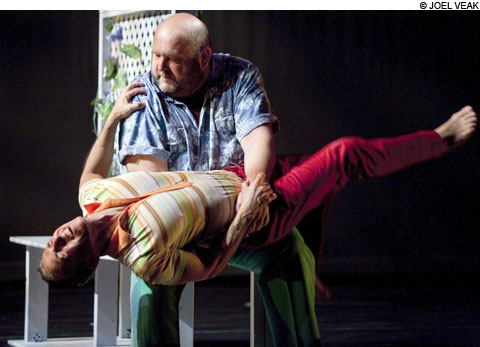
CONTRASTS In Trellis, Roy Fialkow (left) and Lawrence Goldhuber inhabit the uneasy space of their relationship.
|
During the Q&A that followed last weekend's "Summer Reunion" of former dancers from the Bill T. Jones/Arnie Zane Dance Company, Jones — unable to attend — was represented on stage by a large bouquet of white roses. (Zane, who died in 1988, was probably watching through a heavenly viewfinder.) Lovely as they were, the florist should have showcased a mix of vividly colored flowers to correspond to the six very different choreographers who have emerged from the Jones/Zane enterprise and to its all-encompassing diversity.Jones is tall and black. His physique was a sharp contrast with Zane's, who was tiny and white. Lawrence Goldhuber weighs more than 300 pounds. Roy Fialkow is lithe and a whole lot lighter. In Goldhuber's enigmatic Trellis, the men spy on each other through the lattice, read the paper, jog, and approach each other like bobble-headed toys. Fialkow creeps along in a fetal position. Goldhuber slings him over his shoulder, firefighter-style. They inhabit the uneasy space of their relationship.
>> PHOTOS: "Bill T. Jones/Arnie Zane Dance Company at the ICA" by Joel Veak <<
Heidi Latsky's Grace owes as much to Anna Sokolow's 1945 Kaddish as it does to the contemporary work of Jones and Zane. Jeffrey Freeze, his muscular arm and neck trussed with a red scarf, strikes cruciform poses to a thumping heartbeat and, later, a wafting chorale. He looks like an Aztec in Orozco's Dartmouth murals. Dancing an excerpt from Gimp — created for Lisa Bufano, a dancer who uses prostheses — the able-bodied Latsky gave a performance of exquisite alertness, with sudden falls and arms blurring like frantic, powerful wings. As she curled on the floor, her stillness was so energized that you could almost see her wrapping her thoughts around herself as an impenetrable, protective cocoon.
Alexandra Beller was juggling being a new mom and trying to make art when the inspiration for egg came to her in a dream. Beller is another example of Jones's belief that great movers come in all shapes and sizes. She balances an egg on her plush arch, holds it in her mouth, throws it from hand to hand and copes — barely — with an eggy onslaught from her dance company, all while repeating a simple, and simply beautiful, fluid phrase and counting up the number of hours she has spent breastfeeding. There's an old-fashioned postmodern dance-task element to all this — can she and her dancers avoid stepping on the eggs rolling like landmines at their feet? — suffused with whimsy and poignancy.
Sean Curran is an active opera director and in Aria/Apology, he juxtaposes recordings of Renee Fleming singing Handel with horrific confessions left on an anonymous hotline. Danced by the decorous Elizabeth Coker Giron and David Gonsier, Curran's rich choreography raises questions about impropriety and eventually rinses away dysfunction.
The funk stride in Andrea E. Woods's Kujichagulia to the Max/Self Determination to the Max, is choreographically diffuse, but oh those rolling shoulders and stage-spanning leg kicks! Each part of the body, Jones and Woods remind us, plays its own visual music.
I didn't understand the self-indulgent '70s-style video Arthur Aviles showed alongside his Elysian Fields and the stitched-together medley of Jones/Zane greatest hits he danced in Homenaje — but Aviles remains a compact and articulate dancer, and in his choreography for his company he celebrated love in all of its approved and transgressive incarnations. With the back wall of the ICA theater open to the water on a perfect summer night, love and gratitude seemed to embrace all of Boston and beyond.